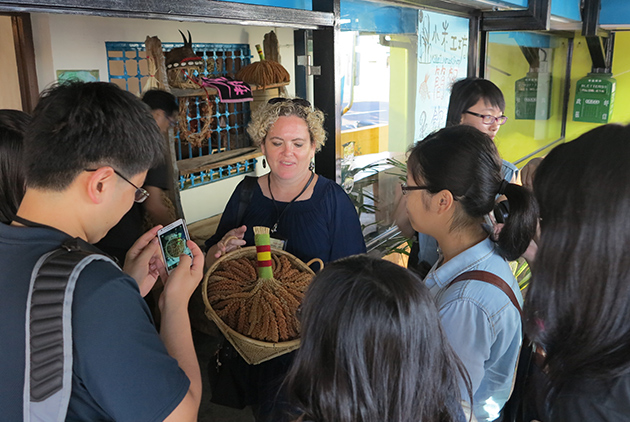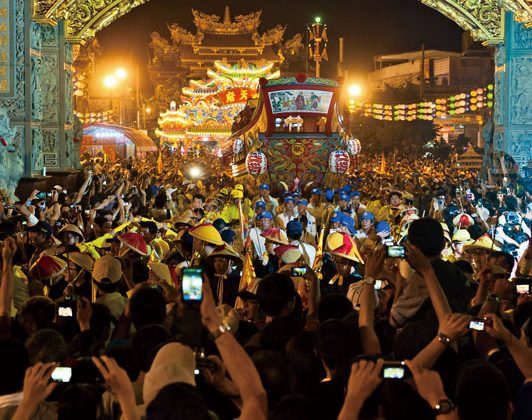Would you be ready to spend NT$8,000 – NT$10,000 per day immersing yourself in the everyday life of an indigenous village in Taiwan? “Never has a tourist tried to haggle over the price. Since they feel it’s worth it, they don’t think of cutting prices,” notes American travel writer and tour guide Cheryl Robbins, who takes visitors on tailor-made tours to the island’s indigenous communities.
When Robbins, scheduled to meet with us in a coffee shop that is tucked away in a Taipei alley, arrives, she laughingly admits that she temporarily lost her way. “I don’t get easily lost in the mountains because there is only one road,” she says. Robbins, who has lived in Taiwan for nearly 30 years, specializes in putting together cultural immersion trips to the island’s indigenous communities.
Robbins, who hails from Los Angeles, is an expert on Taiwan’s indigenous peoples. In 2005, she set up Tribe-Asia, a website that features indigenous handicrafts and cultural tours to indigenous communities. Robbins offers trips of various lengths. There is a mini tour to the Ceroh Community in the southern part of Hualien County, where travelers can experience net fishing, or a two-day tour to Taoyuan Village, a predominantly Bunun community in Taitung County on Taiwan’s east coast. (Read more: Celebrating a Bountiful Millet Crop Amis Tribe – Harvest Festival in Hualien and Taitung)
Travelers with more time on their hands can spend five days experiencing different indigenous cultures in the Sun Moon Lake and Alishan areas. Aside from exploring nature in the mountains, visitors share meals with indigenous families and stay overnight in family-run guesthouses. Through daily interaction, they get to know authentic indigenous life and culture.
The only activity you won’t find on these diverse and exciting itineraries are standard package tour items such as “millet pounding and watching dance and song performances.” During such short stopovers, which typically last two or three hours, it is impossible to truly get to know indigenous peoples and their cultures, and they do not generate sustainable business for the local communities.
Robbins quotes an indigenous friend as telling her with hardly held back anger and frustration: “On package tours, domestic tourists come to visit for two hours. When they arrive, they call us barbarians (derogatory Taiwanese slang for non-Han Chinese), and when they leave, they still call us barbarians.”
Visitors Ready to Pay for Valuable Experience
Robbins organizes small groups of individual travelers, mostly using nine-person vans but maximum a 20-seater bus. Most of her customers are Westerners. Tourists communicate their travel requests and interests through the Tribe-Asia website, while Robbins puts together customized itineraries and personally guides the tours. Cooperating tour operators take care of administrative matters such as taking travel insurance and arranging transportation.
These tours are far from being budget trips as they cost NT$8,000 to NT$10,000 per person per day. However, this includes tour guide, transportation, accommodation, and meals. Yet, Robbins has never heard any complaints from the tourists themselves about the costs. “Only travel agencies say it’s too expensive. But given the services that I provide, the trips can’t be considered costly. Never has a tourist tried to haggle over the price. Since they feel it’s worth it, they don’t think of cutting prices,” she says.
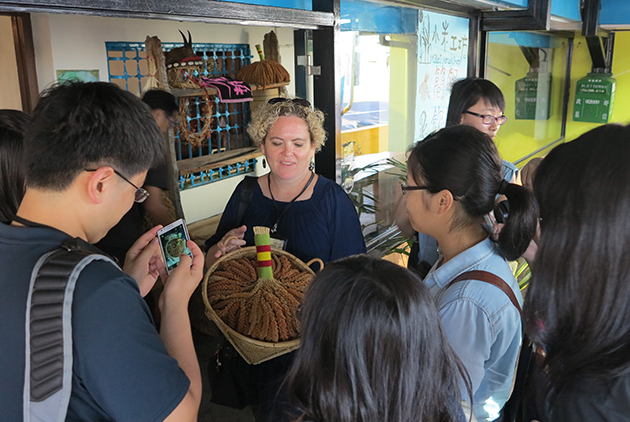
Although the number of visitors is not high, the economic benefits are not necessarily low, since the groups eat, stay and shop in the indigenous communities. Robbins once led a group of seven tourists on a “cultural tour” to an Atayal community in Nanzhuang Township in Miaoli County. The travelers had an indigenous cuisine lunch there and participated in a weaving and dyeing workshop. Before leaving, they bought traditional handicrafts. “They established emotional ties with the community residents. In the end, seven people spent around NT$20,000 to NT$25,00 . So do you want to go for a high number of people and thin profit margins or rather fewer people and higher margins?” Robbins says.
Small but Beautiful, Sustainable Cultural Ecotourism
Robbins believes that the kind of “specialty tourism” she offers has great potential. On the one hand, she says, many city dwellers suffer from a sense of emptiness since they have become disconnected from nature and the soil, which is why they are so drawn to indigenous communities with their strong relationship to their traditional lands and resources. On the other hand, indigenous communities benefit from developing a “small but beautiful” tourism industry that creates jobs, enabling young people to return to their native villages and make a living from preserving their culture. Since tourists visit in small groups, the adverse impact on the local environment can be minimized.
“We want to preserve the culture and the environment, and promote tourism in a responsible manner,” says Robbins. “The indigenous peoples worry about the language barrier with foreigners, but I keep
telling them the foreigners want to get to know you; communication is possible even if you don’t speak the same language.”
Robbins speaks from experience. Influenced by her father, who admired Asian culture, Robbins studied Cantonese as an elective at university in California. Following her Cantonese teacher’s advice upon graduation, she landed a job as an English teacher in Taiwan in 1989. Since then, returning to the United States has never crossed her mind.
“Before that, I had never heard of Taiwan. The first thing I did was go to the library to search for information on Taiwan,” recalls Robbins, who began to learn Mandarin only after coming to Taiwan.
Being unfamiliar with Taiwan, Robbins did not know that indigenous peoples were living on the island. In 1997, she started to work as an English guide and translator at the National Museum of Natural Science in Taichung because she had a background in animal studies. She first came into contact with Taiwan’s Austronesian language communities in the museum’s “human cultures” section. Eager to improve her visitor guidance, Robbins began to read Chinese background materials and pestered her colleagues with questions.
Falling in Love with Indigenous Culture
As it turned out, one of her museum colleagues, who hails from the Rukai people, was just preparing to return home for a visit, so Robbins tagged along to the village of Wutai in Pingtung County. She was smitten with the beautiful nature, including magical waterfalls, the Rukai language, traditional hand tattoos and the flowers used for indigenous headdresses. Subsequently, she began to drive into the mountains to explore life in the indigenous villages. She was surprised to find that the villagers were not hostile at all when she, a complete stranger from abroad, suddenly showed up, instead receiving her with great hospitality.
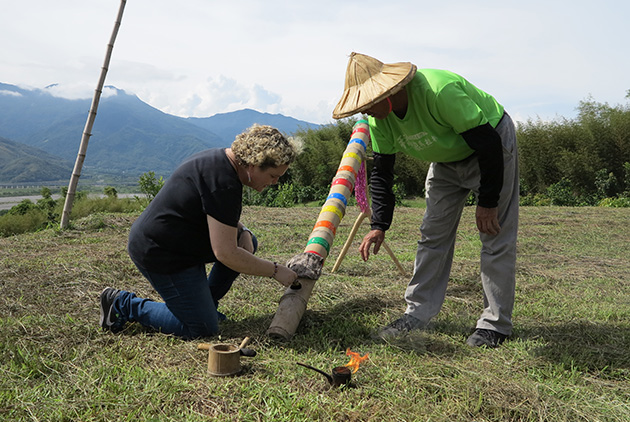
“They would ask me if I could speak Chinese. I would say yes, and they would say ‘That’s great, come and eat with us’. That’s how I began to get to know more people. When I want to go to a community that I’m not familiar with now, I can make some phone calls and ask whether they know someone there. There is always someone who answers: ‘Go and ask for so- and-so’,” says Robbins.
Drawing on her longtime interaction with indigenous communities, Robbins co-authored the book “The Real Taiwan and the Dutch: Traveling Notes from the Netherlands Representative” to gether with former Netherlands Representative Menno Goedhart, which was published in 2010. It describes the shared Taiwanese and Dutch history, tells stories of interactions between the Dutch and indigenous people that appear in the oral histories of a number of tribes, and introduces recommended itineraries.
Robbins obtained a distance learning masters degree in cultural management from Northumbria University in Britain. But since Taiwan’s Ministry of Education does not recognize online degrees, she moved to Hualien from Taichung this year to take a masters course at the College of Indigenous Studies of National Dong Hwa University. Upon graduation, she plans to go for a doctoral degree. “Indigenous cultures fascinate me,” she declares.
Robbins did not fall in love with Taiwan only because of its indigenous peoples, but also because of the island’s diversity and vitality. Taiwan features Han Chinese and indigenous cultures, and has also absorbed Western and Japanese influences. Since Taiwan is not large, both its coasts and mountains can be reached in a few hours, which makes traveling very convenient.
Everyday life in Taiwan’s conurbations differs greatly from life in the United States, where, Robbins says, people return to uneventful, quiet suburbs after work, while in Taiwan even the bookstores are open round-the-clock, and there’s always something to do. (Read: Mercedes-Benz Taiwan-German CEO Takes Lead in Local Reforestation)
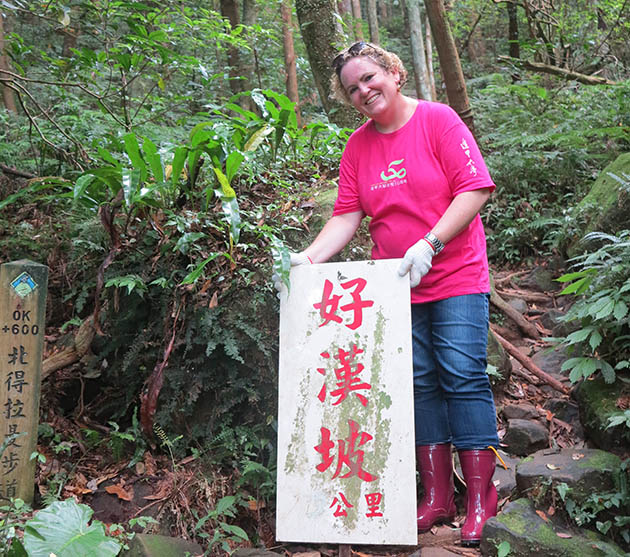
“American life is relatively boring, but in Taiwan I very seldom feel bored,” says Robbins.
How to Sell Taiwan to Visitors
Many travelers feel the same as Robbins. With its friendly people, rich natural beauty, diverse scenery and unique mix of modernity and tradition, Taiwan leaves a lasting impression on travelers. So why aren’t more tourists from Europe and North America visiting Taiwan? (Read: Finding a Media Niche-A German Voice for Taiwan)
“Almost 99.9 percent of people who come here fall in love with Taiwan. The most important point is how to attract people to come to Taiwan in the first place. The problem lies with marketing: Western people don’t really understand the Taiwanese way of marketing,’ Robbins says.
Taiwan’s tourism slogan, for instance, is “Heart of Asia”. For Robbins, it is not clear what message that slogan is supposed to convey. From a geographical perspective, Taiwan, she says, is not located at the heart of Asia at all. From a more abstract perspective, the heart-shaped logo used in the Heart of Asia campaign features a hodgepodge of tourism-related illustrations such as the Taipei 101 skyscraper, a steaming teapot, and a dining couple, causing Robbins to say that Westerners cannot really understand what Taiwan actually stands for.
Taiwan’s Mountains Most Attractive
Taiwan does in fact offer great food. However, Robbins asks: “Who would travel half around the world to Taiwan just for good food?” Taiwan has some beautiful cycling paths, but what Westerners are more interested in, is circling the island. Robbins suggests that more information could be made available for the cycling community. “For instance, from where to where and how many kilometers can you ride in a day to complete the ride around the island in nine, 11 or 13 days, and so on,” she points out.
Robbins believes that Taiwan’s mountains should be promoted with much more fanfare. Having grown up as a “mountain girl” in an area near the foothills in Los Angeles County, Robbins was surprised to find out that the small island of Taiwan boasts many mountain peaks higher than 3,000 meters. When asking her clients what amazed them most during their visit to Taiwan, they all respond: “the mountains.”
“Taiwan does, of course, have beautiful coastline, but to be honest, it can’t compare with other places when it comes to holiday resorts where you lie on the beach while people serve you cocktails. But Taiwan doesn’t just have mountains; these mountains are also very beautiful,” says Robbins. “The next question they have is whether there are mountain activities. This is a problem of promotion,” she says.
Asia’s Best-Kept Secret
“Taiwan has many potential niche markets but has not exploited them, instead repeating the same campaigns over again. People who love Taiwan as much as I do feel very frustrated. I don’t mean to criticize; I just hope that people can see this potential,” she says. Robbins suggests that Taiwan should not always follow trends but take advantage of its diversity to innovate its tourism.
“I feel Asia’s Best-Kept Secret is a slogan that Taiwan could use, since many Westerners don’t know Taiwan yet; this disadvantage could be turned into an advantage if it were used to stir up curiosity,” Robbins suggests.
Translated from the Chinese Article by Susanne Ganz
Edited by Shawn Chou
(This article is reproduced under the permission of CommonWealth Magazine English Website. It does not represent the standpoint of Taiwan Scene.)
Related content: First Dawn Flight, Tribal Rites and Beautiful Taitung: A Unique Way to Spend New Years in Taiwan

